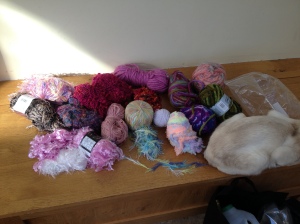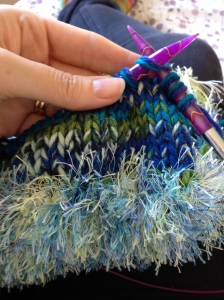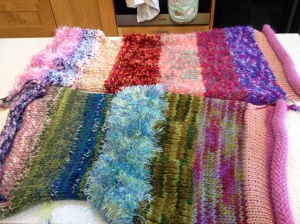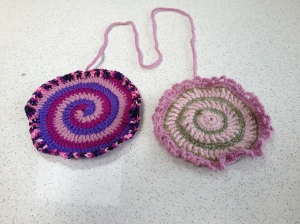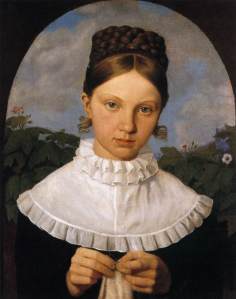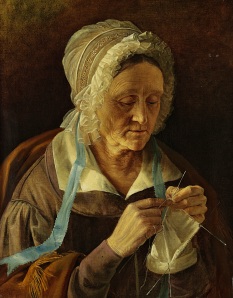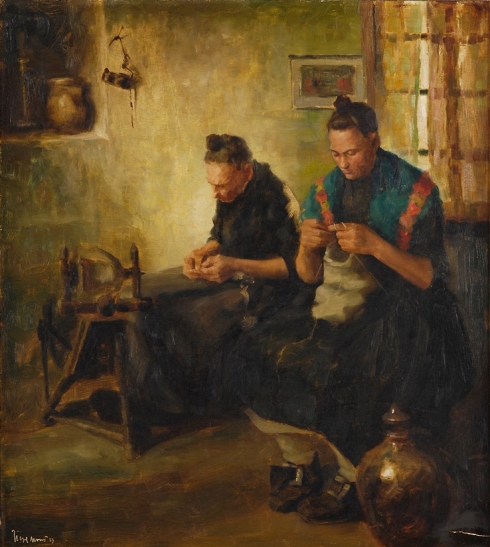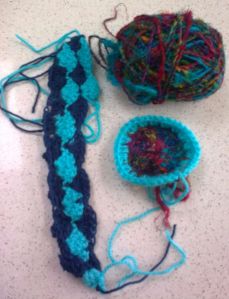
Mel's freeform crochet
Once I had a first love . . .
When I knat as a teenager, I had one project on the go at a time. It was usually a jumper (sweater) and I worked on it until it was finished. This seemed the natural thing to do and I never realised that there was another way.
When I came back to knitting after a 20-year gap, things were very different. I simply couldn’t entertain the idea of project monogamy now. Looking at my Ravelry project will show that I have 5 wips (works in progress) at the moment. (On Ravelry, I am funkyforty – find me and make me a friend :))
. . . then a shawl . . .
The longest running is a lace shawl that I started in July last year. It escaped the end-of-year cull because I did a few rows on it and decided to continue, but haven’t touched it since. It’s easy enough to do, but I’m not sure I will have enough yarn to make it long enough, which is denting my enthusiasm. So, I always find something I’d rather do. My heart says that I will go back to this and finish it, but it won’t escape another cull so if it isn’t finished this year, it will be frogged and stashed.
. . . and hexipuffs . . .
Next oldest is the hexipuff project. It’s a collection of cute little stuffed heaxagons that you make into a quilt or something similar. I have that in my handbag and it’s what I do when I’m sitting in the doctor’s waiting room or turned up early for something. That will go on until I have enough to make a quilt, which will not be this year.
. . . and freeform crochet . . .
Then there’s my freeform crochet project. I bought a skein of wierd and wonderful yarn at the Knitting and Stitching Show in Harrogate in November and then picked out some of the colours in other yarns. And when I feel like it, I crochet what I fancy in any shape and size. When I have enough, I will put them together, fill in the gaps with crochet then crochet them together into cushion covers for the front room.
. . . and two jumpers . . .
Then this year’s new projects are two jumpers for me – going back to my teenage passions. I loved making aran jumpers – cream sweaters with complicated cable patterns, favoured by fishermen! I even designed my own pattern once, but can’t remember if I finished knitting it. So, I have one of those and one lacy jumper in a drapey blue yarn and I am making good progress on them both.
. . . and here’s why
So, why do I have so many projects at once? Well, I have to be in the right mood to do the freeform crochet: I need to feel creative and imaginative and ideally come to it with a new idea. I have to concentrate a bit on the aran as the pattern is on several different sheets and I have to refer to it all the time. The blue is easy because I know the pattern now so I can do that when I’m teaching. And the lace will have its day eventually. Sometimes I want a challenge – something to get my mental teeth into. Sometimes I want something I can do while people-watching and not make a mistake. Sometimes I want something that will occupy enough of my mind to free me to think clearly. And sometimes I just want to start something new because that’s the mood I’m in.
And because it’s my hobby, I do what I want to and won’t allow myself to make it into a job. No ‘if I make myself do 4 rows a day then the lace will be finished by ….’ because that’s the way I do my work and this is not my work. My MIL doesn’t understand – she says “how do you ever get anything finished?” Well, I do, and even if I didn’t, it doesn’t matter because I am happy 🙂
So, how many projects do you have going? Knitting, crochet, sewing, embroidery, papercraft, spinning, whatever your craft is, tell us about your monogamy, or lack of.
Happy knitting 🙂
